King Bolete
(Boletus edulis)
Conservation • Description • Habitat • Ecology • Distribution • Taxonomy
Conservation Status |
|||
| IUCN Red List | not listed |
||
| NatureServe | NNR - Unranked |
||
| Minnesota | not listed |
||
Description
King Bolete is a large, common, and widespread mushroom. It has a cosmopolitan distribution throughout the temperate zone of the Northern Hemisphere, where it is found in Europe, Asia, North America, and Mexico. In the Southern Hemisphere, it has been introduced unintentionally in southern Africa, Australia, and New Zealand when tree plantations were established. It occurs in most of the contiguous United States, but it is absent from the Great Plains and the Great Basin, and it is mostly absent from the deep south except in the Appalachian Mountains.
At least 55 subspecies, varieties, and forms of Boletus edulis have been described. All but a few of these occur only outside of North America. Many of these are now considered distinct species, and many are now treated as synonyms. Whether the King Bolete of North America is a different species than the Porcini of Europe is a matter of continuing debate. At least five groups of mycologists are researching North American collections of King Boletes. They have identified fourteen “edulis-like” species. Until further research is done, most sources in North America do not recognize taxa below the rank of species. One exception is California King Bolete (Boletus edulis var. grandedulis). As the common name suggests, it occurs only in the far west.
King Bolete is found in deciduous and coniferous forests and in tree plantations, alone, scattered, or in groups, sometimes close together but not clustered (in troops). It can appear any time from spring through fall, but it is especially abundant after heavy rains in the fall. It grows on the ground under conifers, including pine, spruce, hemlock, and fir, and under hardwoods, including oak and birch. It has a mutually beneficial relationship (mycorrhizal) with the tiny rootlets of trees, absorbing sugars and amino acids while helping the tree absorb water.
When it first appears, the cap is convex, hairless, greasy or sticky, and light to dark orangish brown with paler margins. As it ages, the cap spreads out, becoming broadly convex or bun shaped. The mature cap is usually 3″ to 4″ (8 to 10 cm) in diameter, but it is sometimes up to twice that size. It is nearly flat and orangish brown or cinnamon brown, and it becomes tacky when wet. The surface may be smooth or somewhat pitted or pockmarked.
The pore surface is white or whitish at first, and it appears stuffed with pith. As it ages it turns pale yellow. On mature caps, the pore surface is olive yellow. It does not turn blue when bruised. There are 2 or 3 round pores per 1⁄32″ (1 mm), and the pores are up to 1⁄16″ (2 mm) deep.
The stalk is usually enlarged near the base when young. The mature stalk is white with brownish areas. It is usually 2″ to 4″ (5 to 10 cm) long and ¾″ to 13⁄16″ (2 to 3 cm) thick, but it is sometimes much longer and thicker. It may be club shaped, but it is often more or less the same thickness from top to bottom. The surface has a network of fine ridges (reticulate), at least near the top, due to the pores being pulled down the stalk as the stalk lengthens.
The flesh is thick, white, and firm. Unlike other boletes, it does not turn blue or otherwise change color when cut or bruised. It is edible, and it is much sought after in Europe.
The spore print is olive brown.
Similar Species
Habitat and Hosts
Deciduous and coniferous forests and tree plantations
Ecology
Season
Any time, but especially in fall
Distribution |
||
|
Sources |
|
| 8/10/2025 | ||
Occurrence |
||
Common and widespread |
||
Taxonomy
Kingdom
Fungi (Fungi)
Subkingdom
Dikarya
Phylum
Basidiomycota (Basidiomycete Fungi)
Subphylum
Agaricomycotina (Higher Basidiomycetes)
Class
Agaricomycetes (Mushrooms, Bracket Fungi, Puffballs, and Allies)
Subclass
Agaricomycetidae
Order
Boletales (boletes and allies)
Suborder
Boletineae
Family
Subfamily
Boletoideae
Genus
Boletus (porcini and allies)
Subordinate Taxa
California King Bolete (Boletus edulis var. grandedulis)
Synonyms
Boletus crassus
Ceriomyces crassus
Dictyopus edulis
Leccinum edule
Tubiporus edulis
Common Names
Cep (France)
King Bolete (U.S.)
Penny Bun (UK)
Porcini (Italy)
Glossary
Mycorrhizal
A symbiotic, usually beneficial relationship between a fungus and the tiny rootlets of a plant, usually a tree.
Visitor Photos
Share your photo of this fungus.
This button not working for you?
Simply email us at info@MinnesotaSeasons.com.
Attach one or more photos and, if you like, a caption.
Dan W. Andree |
||
8-17-25 King Bolete... It had some grasses growing over areas I had to move out of the way. A little smaller than the other one I seen. |
||
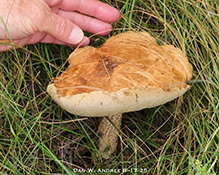 |
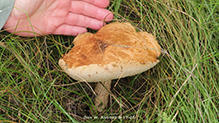 |
|
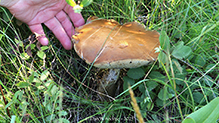 |
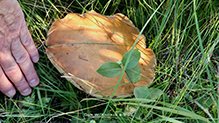 |
|
Interesting Mushrooms... … a large brown one. It reminded me of a pancake when viewed from directly above without the rugged stem showing. |
The king bolete on 8-9-25 from the top reminded me of a pancake. Ha, Ha. |
|
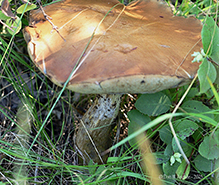 |
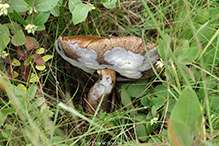 |
|
Whitish areas on King Bolete Mushroom... I went back the following day to the area where I seen this big mushroom and this is what it looked like. Something or someone toppled it over and it had all these large white areas on it. There was also a lot of white areas on the top part though not shown in this photo. Wonder what caused it? In a video clip I did notice insects on the stem area the first time I seen this big mushroom, but didn't notice any on this white area the following day. I didn't spend much time looking as mosquitoes were annoying in that spot. |
||
… if you look close on this photo you can see some small beetle like insects on the stem of the mushroom. My guess is more showed up and they really fed on it. Interesting seeing how some things in nature rely on other things in nature to survive. |
||
Kathryn Wallis |
||
Found on the SHT near Two Harbors. |
||
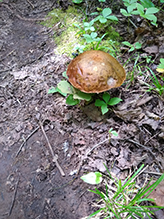 |
||
MinnesotaSeasons.com Photos
|

Slideshows

Visitor Videos
Share your video of this fungus.
This button not working for you?
Simply email us at info@MinnesotaSeasons.com.
Attach a video, a YouTube link, or a cloud storage link.
Other Videos
Large Penny Bun, Porcini, Cep, King Bolete, Boletus edulis identification
Wild Food in the UK
Mushroom Hunting - August 15th 2023 (part 1/2) - Boletus edulis | Cep | King bolete | Funghi Porcini
Luke's Mushrooms
Boletus edulis Sonoma County California USA 2012 Dec 4-12
Glenn Walker
Title
Author

Visitor Sightings
Report a sighting of this fungus.
This button not working for you?
Simply email us at info@MinnesotaSeasons.com.
Be sure to include a location.
Dan W. Andree
8/17/2025
Location: Norman Co. Mn.
It had some grasses growing over areas I had to move out of the way. A little smaller than the other one I seen.
Dan W. Andree
8/10/2025

Location: MN SNA, Norman Co. Mn.
I went back the following day to the area where I seen this big mushroom and this is what it looked like. Something or someone toppled it over and it had all these large white areas on it. There was also a lot of white areas on the top part though not shown in this photo. Wonder what caused it? In a video clip I did notice insects on the stem area the first time I seen this big mushroom, but didn't notice any on this white area the following day. I didn't spend much time looking as mosquitoes were annoying in that spot.
Dan W. Andree
8/9/2025
Location: MN SNA, Norman Co. Mn.
… a large brown one. It reminded me of a pancake when viewed from directly above without the rugged stem showing.
Kathryn Wallis
8/16/2020
Location: Superior Hiking Trail
What are these? Found on the SHT near Two Harbors.
John Valo
3/18/2024
Following Michael Kou’s key on MushroomExpert.com, your mushroom keys out to Boletus cf. edulus. The “cf.” stands for “confer”. It indicates that it likely belongs to that species. It is given that designation because it is not certain that the North American mushrooms identified as Boletus edulis are the same species as the “true” Boletus edulis in Europe.
MinnesotaSeasons.com Sightings |
|





